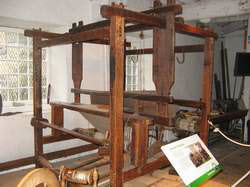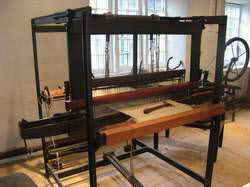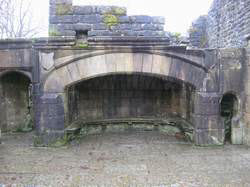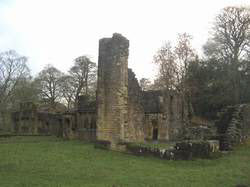Abandoned Communities ..... Wycoller
The weavers of Wycoller would have taken advantage of changing technology in the design of hand looms. In particular they would have adopted the flying shuttle which used a mechanical system to carry the weft thread through the warp. It had been invented by John Kay and patented by him in 1733.
Some of the weavers may have operated in an independent fashion, but it is likely that most of them were employed by a clothier. The clothier would have supplied wool and other raw materials, received and inspected the woven cloth, and paid each worker according to a piece rate system. Rates of pay tended to stay low as the negotiating power of the weavers was weak because so many people took up the occupation and they generally related to the clothier on an individual rather than collective basis.
There is evidence that the people of Wycoller were fully involved in the non-conformist religious movements of the eighteenth century. Methodism was brought to the area around 1742 by William Darney, who mentions Wycoller in a poem written by him. Although Darney was a popular preacher he also encountered opposition, on one occasion being physically attacked while on his way to Wycoller. John Wesley himself made several visits to the area between 1747 and 1786. A Methodist chapel was built in Colne before his visit in 1777, but so many people crowded in to see him that the gallery collapsed.
The Inghamites were another denomination that gained much support in Wycoller. Their founder, Benjamin Ingham, had been ordained in the established church in 1735 but started to form independent groups in Yorkshire around 1740. Ingham's first trip into Lancashire took place in February 1740, Wycoller being the first village on his journey after he had departed from Haworth. In 1752 an Inghamite chapel was built in Winewall, a village between Wycoller and Colne. More than 130 inhabitants of Wycoller were buried in the graveyard at Winewall chapel between 1770 and 1820.
Wikipedia has a page on Benjamin Ingham, with a photograph of Winewall chapel.
The last main occupant of Wycoller Hall was Henry Owen Cunliffe. Cunliffe inherited the estate at the age of 21 in 1773. We know a lot about him as he was closely observed by Elizabeth Shackleton of Alkincoats, who often wrote about him in her diary. Shackleton, whose sons became close friends with Cunliffe soon after he arrived in Wycoller, was irritated by Cunliffe's small talk, pomposity, and tendency to offend, but she evidently appreciated the potential for a rich source of gossip. Cunliffe enjoyed dinner parties, dances, shooting expeditions, and cock fighting. A cockpit was constructed on the hillside above the Hall. He joined the Lancashire Militia, but as he was a small man Shackleton was not impressed by the sight of him in military uniform.
A lot of entertaining quotations from Elizabeth Shackleton's diary can be found in chapter 6 of John Bentley's book.
During his first two years at Wycoller Hall Cunliffe organised several alterations. A porch with ornamental finials was added, and a large fire-place installed in the main room. New windows were fitted in the three-storeyed southern end of the Hall. Gardens were laid out close to the Hall and trees were planted. Then in August 1775 Cunliffe married Mary Oldham, daughter of a wealthy hat manufacturer of Manchester. According to Elizabeth Shackleton Mrs Cunliffe was a great talker, high head, and her hair very rough, and together they were a queer pair and uncouth. They had no children.
The Cunliffes moved to the Yorkshire dales in 1802, but Henry would return to Wycoller Hall from time to time to collect the rents and shoot grouse. He died at the Hall in 1818.
After 1818 parts of Wycoller Hall may have been lived in occasionally, but in general the property became derelict. Around 1880 the roof was removed and thereafter the building fell into ruin.
Some of the weavers may have operated in an independent fashion, but it is likely that most of them were employed by a clothier. The clothier would have supplied wool and other raw materials, received and inspected the woven cloth, and paid each worker according to a piece rate system. Rates of pay tended to stay low as the negotiating power of the weavers was weak because so many people took up the occupation and they generally related to the clothier on an individual rather than collective basis.
There is evidence that the people of Wycoller were fully involved in the non-
The Inghamites were another denomination that gained much support in Wycoller. Their founder, Benjamin Ingham, had been ordained in the established church in 1735 but started to form independent groups in Yorkshire around 1740. Ingham's first trip into Lancashire took place in February 1740, Wycoller being the first village on his journey after he had departed from Haworth. In 1752 an Inghamite chapel was built in Winewall, a village between Wycoller and Colne. More than 130 inhabitants of Wycoller were buried in the graveyard at Winewall chapel between 1770 and 1820.
Wikipedia has a page on Benjamin Ingham, with a photograph of Winewall chapel.
The last main occupant of Wycoller Hall was Henry Owen Cunliffe. Cunliffe inherited the estate at the age of 21 in 1773. We know a lot about him as he was closely observed by Elizabeth Shackleton of Alkincoats, who often wrote about him in her diary. Shackleton, whose sons became close friends with Cunliffe soon after he arrived in Wycoller, was irritated by Cunliffe's small talk, pomposity, and tendency to offend, but she evidently appreciated the potential for a rich source of gossip. Cunliffe enjoyed dinner parties, dances, shooting expeditions, and cock fighting. A cockpit was constructed on the hillside above the Hall. He joined the Lancashire Militia, but as he was a small man Shackleton was not impressed by the sight of him in military uniform.
A lot of entertaining quotations from Elizabeth Shackleton's diary can be found in chapter 6 of John Bentley's book.
During his first two years at Wycoller Hall Cunliffe organised several alterations. A porch with ornamental finials was added, and a large fire-
The Cunliffes moved to the Yorkshire dales in 1802, but Henry would return to Wycoller Hall from time to time to collect the rents and shoot grouse. He died at the Hall in 1818.
After 1818 parts of Wycoller Hall may have been lived in occasionally, but in general the property became derelict. Around 1880 the roof was removed and thereafter the building fell into ruin.
Three
A handloom before the introduction of the flying shuttle
Handloom with flying shuttle
The looms in these two photographs can be seen in the Helmshore Textile Museum
The fire-
The ruins of Wycoller Hall in January 2011



